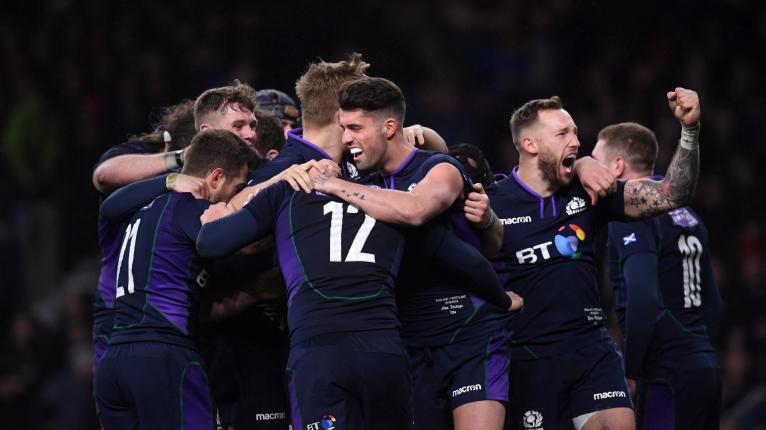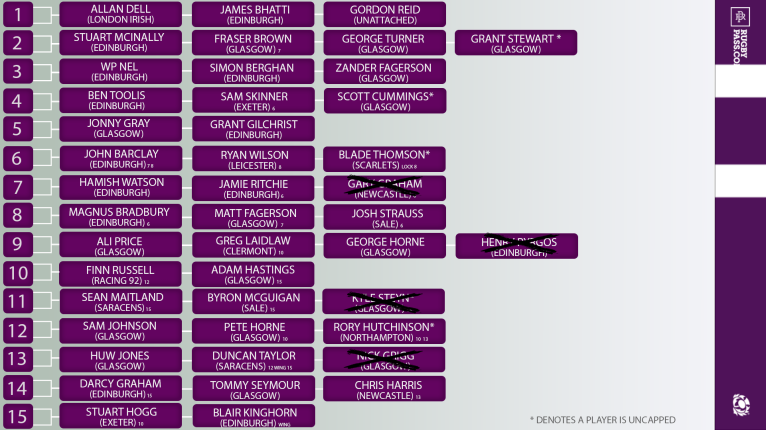Welcome back Duncan Taylor, a creature so rare that fans must be wondering if he exists at all

Most welcome and most appetising in Scotland’s line-up for their first of four World Cup warm-up Tests is the start at No12 for Duncan Taylor, a creature so rare that fans must be wondering if he still exists at all.
Taylor has endured a torturous spate of injuries these past few seasons – the nuanced and maddening menace of concussion, a back problem and two damaged knee ligaments – such that he has taken on an almost mythical status.
He hasn’t been seen on a rugby pitch in almost a year, and last played a Test match in June 2017. Watching Taylor walk out in France next Saturday night wearing a Scotland jersey will be like seeing a dodo strut down Princes Street.
A glorious sight it will be nonetheless, for Taylor is a supreme operator. Why else would Gregor Townsend select a player who last took the field in September 2018, while dropping two of Glasgow’s form men over the past two seasons in Nick Grigg and Kyle Steyn?
Why else would all-conquering Saracens have given Taylor a contract through to 2021 in spite of that heinous injury record?
BREAKING | Scotland team named to face France in this Saturday's opening Summer Test in Nice (kick-off 8pm BST) – live on Premier Sports #AsOne ????????? pic.twitter.com/HOKOzaA2Do
— Scottish Rugby (@Scotlandteam) August 14, 2019
Taylor is a potentially massive asset to Scotland, a formidable specimen who can attack, defend and lead, and who possesses the precious quality of versatility. He will feature primarily as a centre, but can very comfortably step in at wing or full-back.
On that 2017 summer tour where he won his most recent caps, he played in all three positions. If he stays healthy – and given all that has befallen him, it is a big if – he might be asked to do the same in Japan.
The Saracens man came through a bounce match against Edinburgh last week, but how his body and mind will cope with the rigours of the Test game is another matter.
https://www.instagram.com/p/B0eHkcJJGxg/
There will be intrigue too around Rory Hutchinson, the Northampton Saints centre who took the Premiership by storm last season and will make his debut from the bench. As recently as December, Hutchinson was by his own admission “fighting for a job”, recovering from injury with a frugal haul of first-team appearances to his name.
He delivered a sensational response. From February to end of Saints’ Premiership campaign, Hutchinson scored four tries, contributed five assists, made 17 clean breaks and beat 36 defenders in 11 starts. Like Taylor, the 23-year-old has versatility on his side – he can play anywhere across the midfield axis – and a fine defensive game, a quality Townsend is understandably keen to see in his centres.
We might well see him introduced at 10 for Adam Hastings where he has served with distinction in the national age-grade sides and where he might put pressure on Pete Horne, Townsend’s preferred option as a second distributor who can plug several holes.

In among all of the anticipation at Taylor’s great comeback and Hutchinson’s emergence, you have to feel for Grigg, an effervescent little buzz-bomb of a centre who started Scotland’s last three Tests, only to be jettisoned from the squad without a single crack at a warm-up match.
Granted, Grigg was fielded in the Six Nations in part because of injuries to Taylor and Huw Jones, but even as the tournament went on, he made noticeable strides in his tackling and defensive positioning. Steyn, too, blasted from nowhere to become one of Glasgow’s go-to men in their run to the PRO14 final – he, too, can cover the back-three.
Having Grigg and Steyn available for the early throes of the season will be a welcome boost for Glasgow at a time when they will be shorn of so much talent, but already the cold reality of elite rugby is being keenly felt. This is the first real opportunity for so many in the most fiercely contested areas of the squad to raise their hands.

The starting loosehead, Jamie Bhatti, is likely vying with Gordon Reid, the replacement, for a berth alongside first-choice Allan Dell. Bhatti has the stronger presence around the field; Reid is superior at the set-piece.
Ben Toolis, Jamie Ritchie and Josh Strauss face a monumental audition, for the back-five of the scrum is where Townsend can call upon a bountiful well of riches.
Can Strauss produce his best stuff over the course of 80 minutes, rather than rousing but fleeting bursts of carries? Toolis and Ritchie were two of Scotland’s top performers in the Six Nations, but with Sam Skinner, John Barclay and Hamish Watson fit again, and Jonny Gray hitting wonderful form at the end of the season, can they pick up where they left off?
????????? Voici votre équipe pour ce premier match de préparation à la Coupe du Monde samedi soir à Nice contre l’Écosse ! Allez les Bleus ! #NeFaisonsXV ! #FRAECO #RWC2019 pic.twitter.com/VQ5vdeKpJT
— France Rugby (@FranceRugby) August 15, 2019
Jones, too, must rediscover the sort of scintillating rugby he showed in his first two seasons, the blistering attack that earned him 10 tries in his first 16 Tests. He got injured two games into the Six Nations and in two years at Glasgow, has barely fired a shot.
He is a phenomenal weapon to wield on his game, but with the immense competition across midfield from Taylor, Horne, Hutchinson, Chris Harris and the outstanding Sam Johnson, his spot is far from secure.
The man with least to lose is Byron McGuigan, whose chances of ousting one of the star names from a probable back-three allocation of five looks slim. Stuart Hogg, Sean Maitland, Darcy Graham, Tommy Seymour and Blair Kinghorn are the strongest candidates, but Taylor’s versatility, fitness and form permitting, might allow Townsend to take one fewer.
‘You get to a ceiling and until you can break through it, it’s hard to keep improving… I need to get my players into better competitions’
– @GeorgianRugby boss @MiltonHaig tells @JLyall93 what is needed to lift them to the next level ?https://t.co/aNLvUp8X1M— RugbyPass (@RugbyPass) August 14, 2019
McGuigan was excellent in the bedlam of Scotland’s roaring second-half comeback at Twickenham and will be next in line for the final cut if one of the top five goes down.
Scott Cummings, a late addition to the squad after a fantastic few months with Glasgow, will get his debut off the bench, and although he is the outsider among the locks, he has time to shake up the pecking order.
Cummings is a player in the Townsend mould – athletic, nimble, a clever footballer and a relentlessly hard worker. In Glasgow’s last four games of the season, and their run to the PRO14 final, he made 72 tackles and carried 79 metres with the ball in hand. At 22, Cummings is callow, but he has bucket-loads to offer.
https://www.instagram.com/p/B1GUHbTo3JO/
The outcome at the weekend doesn’t carry the seismic importance of a Six Nations Test or tournament rugby, but it is significant nonetheless. Scotland last won in France 20 years ago.
Since the last World Cup, they have played 13 away Tests against tier one opposition and won four. Two of those victories came in the Six Nations, both against Italy. Another was a rout of a truly hapless Argentina in the death throes of Daniel Hourcade’s coaching reign and the most notable a fantastic win over Australia two years ago.
Scotland last won in Cardiff in 2002, in Dublin in 2010 and at Twickenham over 30 years ago, albeit they came mighty close in the mayhem of the final day of the Six Nations.
For all that Vern Cotter and then Townsend have made Scotland better – a team to be taken seriously – their away record is an abomination. For all that Saturday is about combinations and cohesion and men pressing their cases for a seat on the plane, it is also about a Scotland team showing they can go to France and win.
The selection quarrels in the bars and clubhouses can begin, the fantasy XVs meticulously constructed and so too the second-guessing of Townsend from Shetland to Selkirk. Suddenly, the road to Japan has a tangible feel.
WATCH: Part one of Operation Jaypan, the two-part RugbyPass documentary on what the travelling fans can expect to experience in Japan
































































